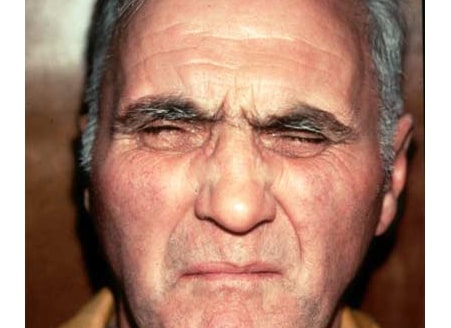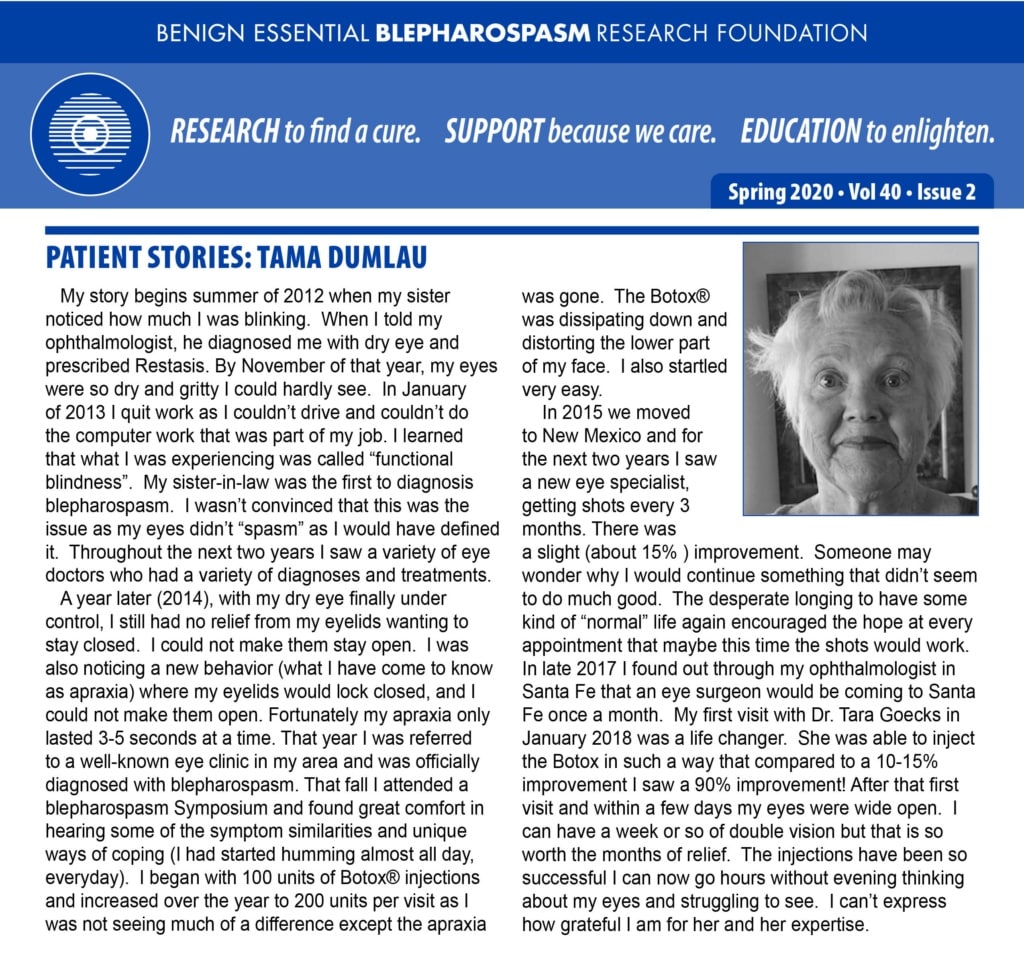Blepharospasm
What is a Blepharospasm?
Blepharospasm is a disease in which there is repeated and uncontrollable muscle contraction around the eyes and eyebrows. Blepharospasm does not occur during sleep and is often exacerbated by stress, dry eyes, and bright lights. Blepharospasm can be disabling and was the original reason that Botulinum toxin (Botox) was developed in the 1980’s.

What Causes Blepharospasm?
Unfortunately, the underlying causes of this condition are unknown. However, the disorder is often associated with basal ganglion dysfunction. The basal ganglion is the part of the brain that controls muscular movement. Some cases of blepharospasm seem to have a genetic component with patients having a family history of the condition.
Symptoms of Eyelid Spasms
This condition develops gradually. In the beginning, patients report excessive blinking and eye irritation caused by stress factors. These factors could be bright lights, fatigue, or distress. Blepharospasm is often presented in both eyes, and the symptoms progressively occur more frequently over time. Eyelid spasms do not occur while patients are sleeping, and people often report experiencing relief upon waking up. In the most severe cases, patients may not be able to open their eyes for hours.
Types of Blepharospasm
There are two types of eyelid spasms that people experience, primary and secondary.
- Primary Blepharospasm: This condition manifests spontaneously. The medical name for primary blepharospasm is benign essential blepharospasm. This means that the condition is non-threatening and does not have a known cause.
- Secondary Blepharospasm: The conditions is often caused by exposure to certain drugs or is developed in connection to other disorders. Disorders associated with eyelid spasms include Parkinson’s disease and Wilson’s disease.
Eyelid Spasm Treatment
Blepharospasm can be treated with Botox. Botox is a medicine that can reduce involuntary muscle spasms around the eyelids and eyebrows. Botox is administered in the office in small amounts through tiny injections. Typically, no anesthetic is necessary, and for this purpose, Botox treatment is usually covered by health insurance.
Who is a Good Candidate for Blepharospasm Treatment?
Blepharospasm is a medical disease and treatment is recommended for anyone whose life and activities are disturbed by the symptoms. Insurance coverage is usually available, although a pre-approval process may be required.
Patient Story
Eyelid Spasm Treatment Options
Treatment with Botulinum toxin injections reduces the spasm that closes the eyes and improves a patient’s ability to use the eyes for everyday life.
"From walking into the office for a consultation to leaving the office after my eyelid surgery recheck, I was treated with respect and kindness. Everyone in the office was welcoming. Dr. Fante was professional but personable and put me at ease right away. My entire experience was great. I have no complaints."
How Much Botox is Needed?
Finding the correct dose may require some trial and error. Too much toxin will make it hard to blink appropriately and cause eye irritation, while too little will fail to provide enough improvement. In general, we try to find the lowest dose that adequately controls symptoms and permits a return to normal life, but it is important to remember that the effect of botulinum toxin only lasts about three months and most patients will have four treatment sessions each year.
How Does Botox Treat Eye Spasms?
The “muscle relaxant” effect of the Botox lasts about three to four months and can be repeated as needed. Rarely, surgery is needed when Botox no longer works. Dr. Fante’s research on treatment of Blepharospasm has been published in the peer-reviewed medical literature. He has performed tens of thousands of Botox injections.
Alternative Blepharospasm Treatments
Although repeated botulinum toxin injections are the mainstay of treatment for most patients, other ancillary interventions can help. These vary in usefulness among different people, but generally include adding FL-41 Tint for eyeglasses, wearing a headband or hat, treating any dry eye, allergies, or blepharitis to avoid triggers, and practicing meditation. Patients often report small lifestyle changes that help them in the quarterly newsletter of the Blepharospasm Research Foundation (see BEBRF.org) and the Foundation is also a great resource for support groups, meetings, and research programs in Denver and around the US.
Will Botulinum Injections Stop Working?
Rarely, botulinum toxin stops working well after years of treatment and a dosage increase is necessary. Even more rarely, the increased dosage doesn’t work and surgery is considered to permanently weaken the eyelid closing muscles.
What to Expect During Treatment
The surgery is performed in a similar manner to standard eyelid lifting operations under “twilight” sedation in an outpatient surgery center. Dr. Fante can explain the details to you if you ever become a candidate.
Related Disorders to Blepharospasm
Hemi-facial Spasms
Hemi-facial spasm is a related neurological disease in which only one side of the face is affected. Unlike blepharospasm, the lower facial muscles are also affected and mouth twitching is usually obvious. Also unlike blepharospasm, the facial spasm persists during sleep. No cause can be identified for most people, but a small number of patients have a dilated blood vessel inside the brain that pulsates and pushes on the facial nerve. For this minority, a neurosurgery operation can help. Instead, for everyone else, botulinum toxin is our best answer. Interestingly, the toxin lasts longer for people with hemi-facial spasm and injections are only needed 2-3 times per year.
Bell’s Palsy
Another uncommon problem is eyelid twitching after partial recovery from Bell’s palsy and other facial nerve injuries including trauma, acoustic neuroma surgery, and parotid gland surgery. Sometimes this occurs due to misdirected regrowth of the nerves so that the ones that are supposed to go to the lips instead go to the eyelids. The medical name for this is Aberrant Regeneration, and it can be frustrating. Again, botulinum toxin is usually the best answer.
Myokymia
Finally, the mildest and most common eyelid twitching experienced by many people is associated with stress, lack of sleep, and caffeine (think of final exams or a big project at work or a new baby). Usually, this is annoying but subtle, more noticeable to the person who has it than to their friends and family. The medical term for this is Myokymia, and fortunately, it usually resolves on its own when the stress improves. Occasionally, however, a persistent spell of this mild twitching can be treated with a small amount of botulinum toxin to “break” the pattern. Although insurance doesn’t cover it, the dose is small and usually doesn’t have to be repeated.
Schedule a Consultation
If you are experiencing symptoms of blepharospasm, contact Fante Eye & Face Center! Call 303-839-1616 to schedule a consultation with facial plastic surgeon Dr. Robert Fante. You can also submit an online contact form to our office, and we’ll get back to you at our earliest convenience. Our practice serves Denver, Boulder, and surrounding areas in Colorado.



